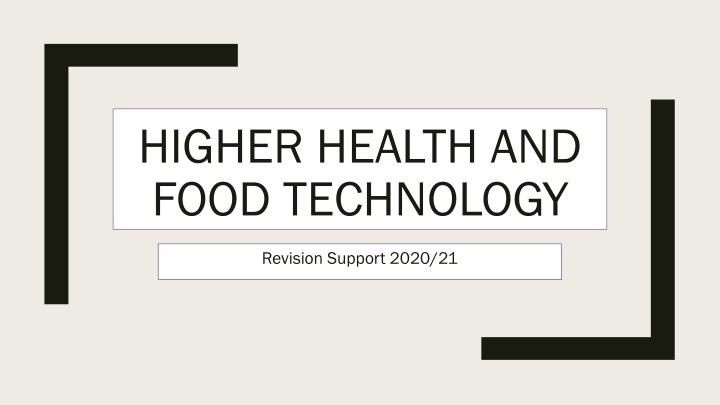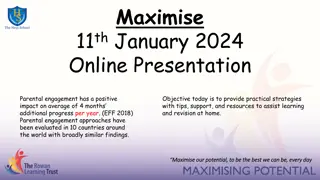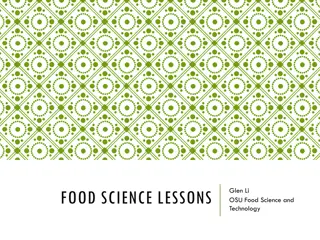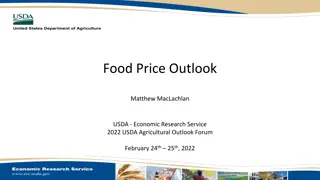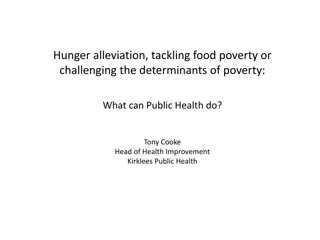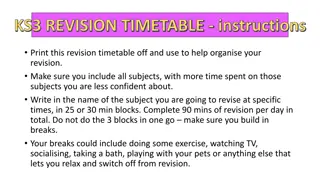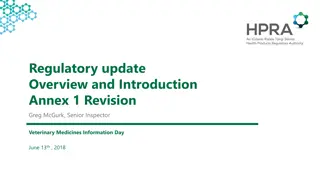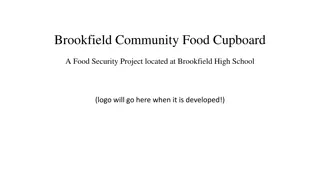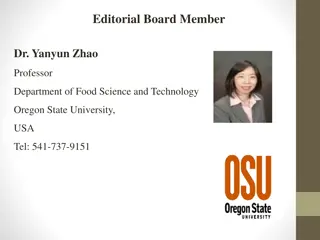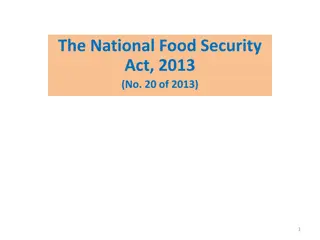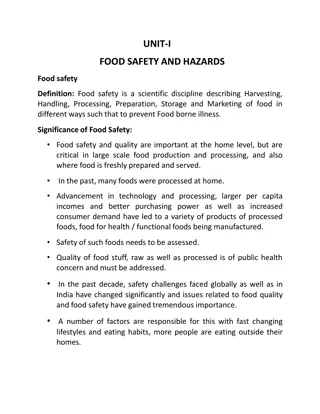Higher Health and Food Technology Revision Support 2020/21
This content provides guidance on answering different types of exam questions in Higher Health and Food Technology, focusing on command words like state, describe, explain, evaluate. It includes examples and strategies for evaluating the impact of using organic ingredients in a cafe and explaining the prevention of cross-contamination in salad production. Additionally, it covers Dietary Reference Values (DRV) in nutrition.
Download Presentation

Please find below an Image/Link to download the presentation.
The content on the website is provided AS IS for your information and personal use only. It may not be sold, licensed, or shared on other websites without obtaining consent from the author.If you encounter any issues during the download, it is possible that the publisher has removed the file from their server.
You are allowed to download the files provided on this website for personal or commercial use, subject to the condition that they are used lawfully. All files are the property of their respective owners.
The content on the website is provided AS IS for your information and personal use only. It may not be sold, licensed, or shared on other websites without obtaining consent from the author.
E N D
Presentation Transcript
HIGHER HEALTH AND FOOD TECHNOLOGY Revision Support 2020/21
Command Words State/Give/What/Name/Identify: State/Give/What/Name/Identify: Candidates are expected to give a short answer /write about a point in a brief sentence. Describe: Describe: Write in detail about a point. Explain: Explain: Identify a point and then follow through with extra detail Evaluate: Evaluate: Give a fact, an opinion (good or bad) and a consequence linked to the scenario FACT/ OPINION/ CONSEQUENCE (caf , elderly man etc) Some examples on the following slide
Command Words - Evaluate Questions Evaluate Questions Answering an EVALUATE EVALUATE exam question When answering an evaluate question you must write your response in THREE parts FACT OPINION CONSEQUENCE To gain further marks in some questions you need to further DEVELOP DEVELOP your answer.
Command Words - Evaluate Questions Evaluate Questions FACT OPINION CONSEQUENCE FACT OPINION CONSEQUENCE Question: Evaluate the impact of using organic ingredients in a cafe. 4 marks 4 marks Note: As there are 4 marks available, you would be expected to write about 4 SEPARATE points POINT - these must be separate FACT - a clear understanding of using organic OPINION - a judgement of suitability CONSEQUENCE - the impact of the needs of the cafe DEVELOP Question: Evaluate the impact of using organic ingredients in a cafe. marks and not a repeat of another ingredients 4 1 Example Organic produce may have a shorter shelf life This may be less beneficial to the cafe As this could lead to more waste for the cafe If this happened regularly, this could contribute to a loss of profits for the cafe
Command Words - Explain Questions Explain Questions Answering an EXPLAIN exam question Answering an EXPLAIN exam question When answering an explain question you must make a number of points that make the issue plain or clear and shows CONNECTIONS CONNECTIONS. To gain further marks in some questions you need to further DEVELOP DEVELOP your answer. Question: Explain how cross-contamination could be prevented when producing salads in the cafe. 3 marks 3 marks Note: As there are 3 marks available, you would be expected to write about 3 SEPARATE Note: As there are 3 marks available, you would be expected to write about 3 SEPARATE points points POINT - these must be separate and not a repeat of another the connections between the stages of preparation/cooking of food therefore preventing cross- contamination CONNECTIONS - you must show DEVELOP - a further mark can be awarded for any explanation that is developed Wash hands in hot soapy water after preparing raw meat and before handling vegetables/salad This prevents the spread of bacteria from the hands to other foods via blood from raw meat Therefore helping to reduce the risk of cross-contamination
What are DRV questions? DRV = Dietary Reference Values DRV = Dietary Reference Values These are questions which compare what the nutrients a person in the case study is eating and to what they should be according to the DRV for that person. Information needing to be used: 1. A comment on the impact of the diet in relation to the Dietary Reference Values and the specific need of the person in the case study. 2. Potential consequences for the health of the person in the case study. 3. A conclusion about the contribution made by his lunch choice to the chosen nutrient intake. (FOOD) (FOOD) 9 mark question ANALYSE ANALYSE 3 nutrient choices LINKED to 3 potential consequences to health LINKED to 3 conclusions about the contribution made by the food to the nutrients chosen
Example Question Case study: Case study: Max is a 34-year-old long-distance lorry driver, is slightly overweight and has a history of high blood pressure in his family. He eats most of his meals at a roadside caf and spends his leisure time playing pool. Dietary Reference Values for men aged 19 Dietary Reference Values for men aged 19- -50 years 50 years Estimated Average Estimated Average Requirements Requirements Guideline Daily Guideline Daily Amount Amount What he should should be having Reference Nutrient Intakes Energy Energy (MJ) (MJ) 11.5MJ 11.5MJ Protein (g) 55.5g 55.5g Sodium (mg) 1600mg 1600mg Vitamin A (Ug) 700Ug 700Ug Iron (mg) 8.7mg 8.7mg Fibre Fibre (g) (g) 18 18 Cheese & bacon, omelette with tomato White toast Orange juice Dietary Analysis of his typical day s meals Dietary Analysis of his typical day s meals Sodium (mg) Energy Energy (MJ) (MJ) Protein (g) Vitamin A (Ug) Iron (mg) Fibre Fibre (g) (g) What he is is having 9.5MJ 9.5MJ 59.9g 59.9g 1641 mg 1641 mg 539 Ug 539 Ug 5.43mg 5.43mg 15g 15g
Information to think about The individual needs activity levels, job etc. What may happen there is too much/too little of the nutrients intake. The source, function & deficiency cause of each nutrient. Which food choice contributes to the nutrient chosen. Protein Protein Iron Iron Vitamin A Vitamin A Protein Protein Sodium (salt) Sodium (salt) Protein Protein Sodium Sodium (salt) (salt) Cheese & bacon omelette with tomato Cheese & bacon omelette with tomato Fibre Fibre Vitamin C Vitamin C (iron absorption) (iron absorption) White toast White toast Fibre Fibre Vitamin C Vitamin C (iron absorption) (iron absorption) Carbohydrate Carbohydrate Iron Iron Sodium (salt) Sodium (salt) Fresh Orange Smoothie Fresh Orange Smoothie
The Case Study Max is a 34-year-old long-distance lorry driver, is slightly overweight and has a history of high blood pressure in his family. He eats most of his meals at a roadside caf and spends his leisure time playing pool. The person in the case study is: The person in the case study is: 34 Male Long-distance lorry driver = sedentary job (not very active) but needs to be fit enough to drive and be able to have good eyesight Slightly overweight = needs to watch the quantity of food he eats/lose weight High blood pressure in the family = needs to take care regarding sodium intake, calories, potential heart disease Eats mostly in roadside caf = could be food high in salt, sugar, fat and calories and low in fruit and vegetables and fibre Plays pool = has a sedentary down job and plays pool, so is not physically very active and does not burn off calories easily
PICK A NUTRIENT TO COMPARE ENERGY Dietary Reference Values for men aged 19 Dietary Reference Values for men aged 19- -50 years 50 years Estimated Average Estimated Average Requirements Requirements Guideline Daily Guideline Daily Amount Amount What he should should be having Reference Nutrient Intakes Energy Energy (MJ) (MJ) 11.5MJ 11.5MJ Protein (g) 55.5g 55.5g Sodium (mg) 1600mg 1600mg Vitamin A (Ug) 700Ug 700Ug Iron (mg) 8.7mg 8.7mg Fibre Fibre (g) (g) 18 18 Dietary Analysis of his typical day s meals Dietary Analysis of his typical day s meals Energy Energy (MJ) (MJ) Protein (g) Sodium (mg) Vitamin A (Ug) Iron (mg) Fibre Fibre (g) (g) What he is is having 9.5MJ 9.5MJ 59.9g 59.9g 1641 mg 1641 mg 539 Ug 539 Ug 5.43mg 5.43mg 15g 15g Fact Fact compare & contrast the figures taken from tables for each chosen nutrient. Opinion/ consequence Opinion/ consequence how it could affect the person in the case study and the possible dietary diseases/conditions that there could be an increased risk of developing. Food Choice Food Choice link the item/s from the given menu which contains each chosen nutrient.
Example answers EXAMPLE ANSWER 1: EXAMPLE ANSWER 1: Max is having a lower energy intake than he should be. This could cause him to become tired and lose concentration when driving long distances in his lorry. This could affect him being able to do his job safely. The white toast is a source of carbohydrate and contributes to Max s energy intake. The cheese, bacon & egg could act as a source of energy if Max s carbohydrate intake is restricted. EXAMPLE ANSWER 2: EXAMPLE ANSWER 2: Max is having a lower energy intake than he should be. This could help him lose the excess weight he is carrying and help prevent him developing obesity, high blood pressure, coronary heart disease and strokes. The white toast is a source of carbohydrate and contributes to Max s energy intake.
Example answers continued EXAMPLE ANSWER 3: EXAMPLE ANSWER 3: Max is consuming less energy than he should be. This could be beneficial as he has a family history of high blood pressure and by having less energy he will be able to lose excess weight and help maintain healthy blood pressure. It will also help prevent him becoming more overweight and developing coronary heart disease. Max s choice of white toast contributes to his energy intake.
PICK A NUTRIENT TO COMPARE Protein Case study: Case study: Max is a 34-year-old long-distance lorry driver, is slightly overweight blood pressure in his family. He eats most of his meals at a roadside caf playing pool. slightly overweight and has a history of high roadside caf and spends his leisure time Dietary Reference Values for men aged 19 Dietary Reference Values for men aged 19- -50 years 50 years Estimated Average Estimated Average Requirements Requirements Guideline Daily Guideline Daily Amount Amount Reference Nutrient Intakes What he should should be having Energy Energy (MJ) (MJ) 11.5MJ 11.5MJ Protein (g) 55.5g 55.5g Sodium (mg) 1600mg 1600mg Vitamin A (Ug) 700Ug 700Ug Iron (mg) 8.7mg 8.7mg Fibre Fibre (g) (g) 18 18 Dietary Analysis of his typical day s meals Dietary Analysis of his typical day s meals Sodium (mg) Energy Energy (MJ) (MJ) Protein (g) Vitamin A (Ug) Iron (mg) Fibre Fibre (g) (g) What he is is having 9.5MJ 9.5MJ 59.9g 59.9g 1641 mg 1641 mg 539 Ug 539 Ug 5.43mg 5.43mg 15g 15g
Sodium Case study: Case study: Max is a 34-year-old long-distance lorry driver, is slightly overweight and has a history of high blood pressure in his family. pressure in his family. He eats most of his meals at a roadside caf roadside caf and spends his leisure time playing pool. history of high blood Dietary Reference Values for men aged 19 Dietary Reference Values for men aged 19- -50 years 50 years Estimated Average Estimated Average Requirements Requirements Guideline Daily Guideline Daily Amount Amount Reference Nutrient Intakes What he should should be having Energy Energy (MJ) (MJ) 11.5MJ 11.5MJ Protein (g) 55.5g 55.5g Sodium (mg) 1600mg 1600mg Vitamin A (Ug) 700Ug 700Ug Iron (mg) 8.7mg 8.7mg Fibre Fibre (g) (g) 18 18 Dietary Analysis of his typical day s meals Dietary Analysis of his typical day s meals Sodium (mg) Energy Energy (MJ) (MJ) Protein (g) Vitamin A (Ug) Iron (mg) Fibre Fibre (g) (g) What he is is having 9.5MJ 9.5MJ 59.9g 59.9g 1641 mg 1641 mg 539 Ug 539 Ug 5.43mg 5.43mg 15g 15g
Vitamin A Case study: Case study: Max is a 34-year-old long blood pressure in his family. He eats most of his meals at a roadside caf and spends his leisure time playing pool. long- -distance lorry driver distance lorry driver, is slightly overweight and has a history of high Dietary Reference Values for men aged 19 Dietary Reference Values for men aged 19- -50 years 50 years Estimated Average Estimated Average Requirements Requirements Guideline Daily Guideline Daily Amount Amount Reference Nutrient Intakes What he should should be having Energy Energy (MJ) (MJ) 11.5MJ 11.5MJ Protein (g) 55.5g 55.5g Sodium (mg) 1600mg 1600mg Vitamin A (Ug) 700Ug 700Ug Iron (mg) 8.7mg 8.7mg Fibre Fibre (g) (g) 18 18 Dietary Analysis of his typical day s meals Dietary Analysis of his typical day s meals Energy Energy (MJ) (MJ) Protein (g) Sodium (mg) Vitamin A (Ug) Iron (mg) Fibre Fibre (g) (g) What he is is having 9.5MJ 9.5MJ 59.9g 59.9g 1641 mg 1641 mg 539 Ug 539 Ug 5.43mg 5.43mg 15g 15g
Iron Case study: Case study: Max is a 34-year-old long blood pressure in his family. He eats most of his meals at a roadside caf and spends his leisure time playing pool. long- -distance lorry driver distance lorry driver, is slightly overweight and has a history of high Dietary Reference Values for men aged 19 Dietary Reference Values for men aged 19- -50 years 50 years Estimated Average Estimated Average Requirements Requirements Guideline Daily Guideline Daily Amount Amount What he should should be having Reference Nutrient Intakes Energy Energy (MJ) (MJ) 11.5MJ 11.5MJ Protein (g) 55.5g 55.5g Sodium (mg) 1600mg 1600mg Vitamin A (Ug) 700Ug 700Ug Iron (mg) 8.7mg 8.7mg Fibre Fibre (g) (g) 18 18 The iron and energy could be linked = greater tiredness .. Dietary Analysis of his typical day s meals Dietary Analysis of his typical day s meals Energy Energy (MJ) (MJ) Protein (g) Sodium (mg) Vitamin A (Ug) Iron (mg) Fibre Fibre (g) (g) What he is is having 9.5MJ 9.5MJ 59.9g 59.9g 1641 mg 1641 mg 539 539 Ug Ug 5.43mg 5.43mg 15g 15g Would the Vitamin C help? Would the Vitamin C help?
Fibre Case study: Case study: Max is a 34-year-old long blood pressure in his family. He eats most of his meals at a roadside caf and spends his leisure time playing pool. long- -distance lorry driver distance lorry driver, is slightly overweight and has a history of high Dietary Reference Values for men aged 19 Dietary Reference Values for men aged 19- -50 years 50 years Estimated Average Estimated Average Requirements Requirements Guideline Daily Guideline Daily Amount Amount What he should should be having Reference Nutrient Intakes Energy Energy (MJ) (MJ) 11.5MJ 11.5MJ Protein (g) 55.5g 55.5g Sodium (mg) 1600mg 1600mg Vitamin A (Ug) 700Ug 700Ug Iron (mg) 8.7mg 8.7mg Fibre Fibre (g) (g) 18 18 Dietary Analysis of his typical day s meals Dietary Analysis of his typical day s meals Energy Energy (MJ) (MJ) Protein (g) Sodium (mg) Vitamin A (Ug) Iron (mg) Fibre Fibre (g) (g) What he is is having 9.5MJ 9.5MJ 59.9g 59.9g 1641 mg 1641 mg 539 Ug 539 Ug 5.43mg 5.43mg 15g 15g
Links to Revision Materials On your Higher HFT Microsoft Teams Channel under files you will find a folder of revision materials Please use the Revision support pack to test your knowledge
SQA Past Papers A great way to be prepared for exam style questions is to check out past papers on SQA website. You can even download the marking schemes to check your answers and identify areas of strength or topics which may require further revision Reading marking schemes is a good indicator of how you must implement the command words- without this marks will not be awarded! https://www.sqa.org.uk/sqa/47899.html <<<< Link to past papers & marking schemes
Revision Tips (BBC Bitesize) Make sure you know which topics you need to revise for each subject. Use your exam board specifications as a revision list Make your revision active. Don t just read notes. You could make flash cards, mind maps or use post it notes Watching videos online can really help to bring your notes alive! Test yourself by completing past papers or asking a friend to test you! This will identify areas of strength and weakness Build in rewards for your revision e.g: your favourite snack or using social media
